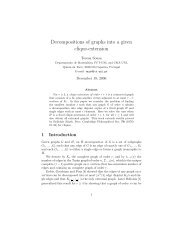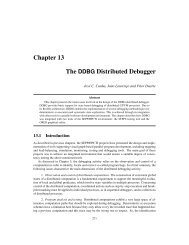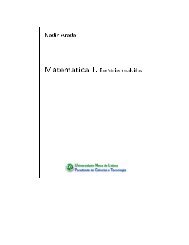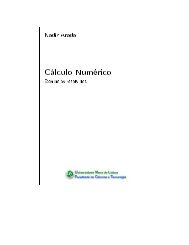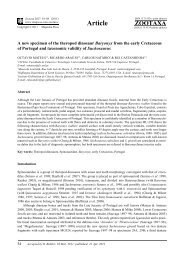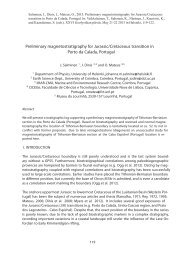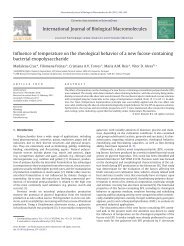Decomposition of graphs into cycles of length seven and single edges
Decomposition of graphs into cycles of length seven and single edges
Decomposition of graphs into cycles of length seven and single edges
You also want an ePaper? Increase the reach of your titles
YUMPU automatically turns print PDFs into web optimized ePapers that Google loves.
Lemma 2.4. φC7(10) = 25.<br />
Pro<strong>of</strong>. The lower bound follows from φC7(10) ≥ ex(10,C7) = 25. We will<br />
now prove the upper bound. Let G be a graph with 10 vertices. Our aim<br />
is to prove that φC7(G) ≤ 25. We have to consider a few cases.<br />
If e(G) ≤ 25 then it suffices to decompose G <strong>into</strong> <strong>single</strong> <strong>edges</strong>.<br />
Assume 26 ≤ e(G) ≤ 43. Suppose first that e(G) = 32, 38, 39. The<br />
upper bound follows since we can greedily remove copies <strong>of</strong> C7 <strong>and</strong> then<br />
remove the remaining <strong>edges</strong>. Suppose e(G) =32(resp. e(G) = 39) <strong>and</strong><br />
suppose that G contains exactly one C7 (resp. two C7’s). Let G ∗ be<br />
the graph obtained from G after deleting the <strong>edges</strong> <strong>of</strong> the C7(’s). Then,<br />
e(G ∗ ) = 25 <strong>and</strong> G ∗ contains no C7. By Lemma 2.3 G ∗ is either K5,5 or<br />
K5 • K6. Therefore, the complement <strong>of</strong> G ∗ must contain a C7, which is a<br />
contradiction since the complement <strong>of</strong> G ∗ is either K4,5 or 2 vertex disjoint<br />
K5’s. Therefore, G contains at least two (resp. three) edge-disjoint C7’s<br />
<strong>and</strong> the result follows.<br />
Consider the case e(G) = 38. It suffices to find 3 edge disjoint C7’s in<br />
G. ThisistrueifG contains a K7 (see Figure 1). Since e(G) ≥ t4(10) = 37<br />
it follows that G contains a K5. We now have to consider two cases.<br />
Case 1: G contains a K6 <strong>and</strong> no K7.<br />
Let V (K6) ={1, 2, 3, 4, 5, 6} <strong>and</strong> A = V (G) − V (K6). Observe that<br />
deg(y, V (K6)) ≤ 5 for all y ∈ A, sinceG contains no K7. Then, e(G[A]) ≥<br />
3. Suppose first that e(G[A]) = 3, then deg(y, V (K6)) = 5 for all y ∈ A.<br />
Let y1 <strong>and</strong> y2 be adjacent vertices in G[A] <strong>and</strong> suppose that y1 is adjacent<br />
to 1, 2, 3, 4, 5. Then,<br />
y1, 2, 1, 6, 5, 4, 3,y1 <strong>and</strong> y1, 1, 3, 5, 2, 6, 4,y1<br />
form two edge disjoint C7’s. If the vertex y2 is adjacent to 3 we have<br />
y1, 5, 1, 4, 2, 3,y2,y1, otherwisewehavey2, 5, 1, 4, 2, 3, 6,y2. We have found<br />
3 edge disjoint C7’s as wanted.<br />
Assume that e(G[A]) = 4. Then, there are y1,y2,y3 ∈ A such that<br />
deg(yi,V(K6)) = 5 for all i =1, 2, 3. Without loss <strong>of</strong> generality assume y1<br />
<strong>and</strong> y2 are adjacent in G[A] <strong>and</strong> the result holds as before.<br />
Finally, suppose e(G[A]) ≥ 5. Then, there are y1,y2 ∈ A such that y1<br />
is adjacent to y2, deg(y1,V(K6)) = 5 <strong>and</strong> deg(y2,V(K6)) ≥ 4. In this case<br />
G[A] iseitheraK4 or a K4 minus one edge <strong>and</strong> since y1 is adjacent to y2,<br />
it follows that the edge y1y2 belongs to a C4 in G[A]. Let y1 be adjacent to<br />
1, 2, 3, 4, 5. Since y1 <strong>and</strong> y2 must have at least 3 common neighbors in K6,<br />
we can assume, without loss <strong>of</strong> generality, that y2 is adjacent to vertices<br />
1, 2, 3<strong>of</strong>K6. Then, Figure 2 shows that G contains 3 edge disjoint C7’s as<br />
required.<br />
Case 2: G contains a K5 <strong>and</strong> no K6.<br />
4



